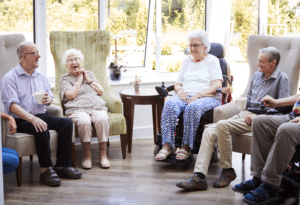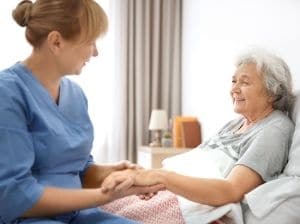
Life as you age can tend to get more difficult. There is no doubt that loneliness can set in as people you love pass away or your family moves farther from you.
Being lonely may not immediately raise any red flags, but there are negative side effects that could possibly stem from it. Stroke, depression, and heart attacks are just some of the symptoms that can accompany being lonely for an extended period of time.
Many people in their older age may not immediately consider the idea, but getting a pet for companionship is a great way to help combat the loneliness they may be feeling.
Of course, getting a pet can be a big commitment. There are many things that may cause you concern, such as how you will clean your home and car while owning a pet. Animals can make a mess sometimes, and many do have a tendency to shed, which can cause a much bigger need to clean.
However, the benefits of pet ownership typically far outweigh the concerns.
Physical Benefits
As a senior, there are many health concerns that arise as you age. However, a great way to help your physical health may be owning a pet. Animals can provide many physical health benefits.
Owning a pet can help with:
- Improved mobility – Walking or playing with a furry friend can greatly increase your mobility from repetitive movements.
- Lowering blood pressure – Petting or cuddling with your companion is shown to reduce stress, which in turn does wonders for your blood pressure.
- Reduced risk of heart disease – Similar to lowering blood pressure, animal interaction can also lower heart rates, which can lead to lower chances of heart disease.
- Increased exercise – Having a pet encourages you to exercise, either by walking them routinely or getting up to give them some attention and playtime.
Mental Benefits
Having a pet stems beyond just physical health benefits. Animal companions also help greatly with mental health.
Having a furry friend can:
- Lower stress levels – Animals bring us a sense of relaxation when they are near. Interaction with a pet can release oxytocin, which in turn helps lower stress levels.
- Decrease feelings of loneliness – Having a pet can greatly reduce the feelings of loneliness that may come with older age. Pets provide a strong sense of companionship to their owners.
- Increase social interaction – Pets may provide more companionship than just themselves as well. People who own pets are more likely to meet new people through conversation starters and shared social settings.
- Increase comfort – Animals bring a strong sense of comfort to their owners when something difficult happens. Whether it be an emotional struggle or physical, having a companion can provide much comfort in hard times.What to Consider Before Choosing a Pet
All the benefits of pet ownership sound wonderful, but there are also factors to consider before going off to purchase your new companion. Pets have many needs, and before making the commitment you should consider whether you will be able to fulfill their needs.
Daily Maintenance
Pets bring so much joy, but they also have needs of their own. One is that most pets will require daily maintenance. Dogs will need to be fed and given fresh water daily, as will cats.
They will also need interaction from you on a daily basis. Dogs need frequent walks, to be taken outside, and play time. Cats will need stimulation and play time.
There is also the cleaning. Dogs will need their feces disposed of, whether right after they go or frequently if you have the yard space to let them outside. Cats will need frequent litter box cleanings.
Expenses
Pets can be costly, which is something to keep in mind before choosing to adopt. Things such as adoption fees, vet bills, pet supplies, and grooming can all add up.
Outside of the routine costs, pets can also have unexpected problems, just as we do as humans. If you decide to get a pet, you should be prepared for the possibility that they may have unexpected costs.
An easy way to mitigate the financial expense of having a pet is purchasing pet insurance. There are different policies available that provide coverage for unexpected pet expenses. Some car insurance policies even include pet coverage.
Location
Before bringing home a pet, consider the living situation. If your home does not have a fenced yard and you live in a climate where it gets cold, you may need to take your dog out in freezing temperatures to use the restroom.
If this is something you are not prepared to do, choosing a pet that doesn’t need to be let outside would be a wiser option.
Making sure your living space is appropriate for the pet you choose is a large factor.
How to Choose the Right Pet
If you have decided everything lines up and you are ready for a furry friend to keep you company, it is important to choose one that works well for you.
Dogs
A dog is a great choice for someone who is not limited in their mobility or looking to improve their mobility. Since dogs require more exercise than other pets, they are best suited for someone who is able to meet those needs.
There are many dog breeds to choose from, with many different personality types. Do some research on breed specifics, and you can be sure to find one that is perfect for you.
Don’t forget! You can also search your local animal shelter for a canine companion. Shelters will typically have a wide variety of dogs for you to choose from.
Cats
Cats can be a great option for a senior who struggles with mobility or does not have outdoor space.
Since cats don’t need to be let outside, they are relatively low maintenance when it comes to mobility needs. Just be sure you are able to clean their litter box frequently and provide them with fresh food, water, and some stimulation throughout the day.
The life of a cat can even be made easier if you prepare some cat diapers! Then you won’t have to worry about fecal & urinary incontinence, spaying incontinence, or heat cycle issues.
Birds or Small Rodents
Pets such as birds, hamsters, or guinea pigs can be lower maintenance options for seniors who don’t want to overwhelm themselves. These animals don’t require much space and simply need feedings, water, and cage cleanings.
They can provide just as much companionship as a cat or dog, with typically less maintenance.
Fish
Fish are extremely low maintenance pet options. They need a small feeding each day and their tank water cleaned. Outside of that, there is not much they require.
Fish are a great option for someone who needs routine in their life but may have trouble with a more high-maintenance pet.
Enjoy Your New Companion
If you have decided a pet is the best option for you in your senior years, you will surely be happy with the love and companionship they bring.
It’s true, pets can take a lot of work. But if you are able to care for them, the benefits they bring can far outweigh the maintenance. From helping you stay physically fit to keeping your mental health strong, having a furry friend in your home can certainly fill many needs you may have.
About the Author: Alexandra Arcand writes and researches for the insurance comparison site, USInsuranceAgents.com and loves animals. She has five pets of her own who she spoils every day.









